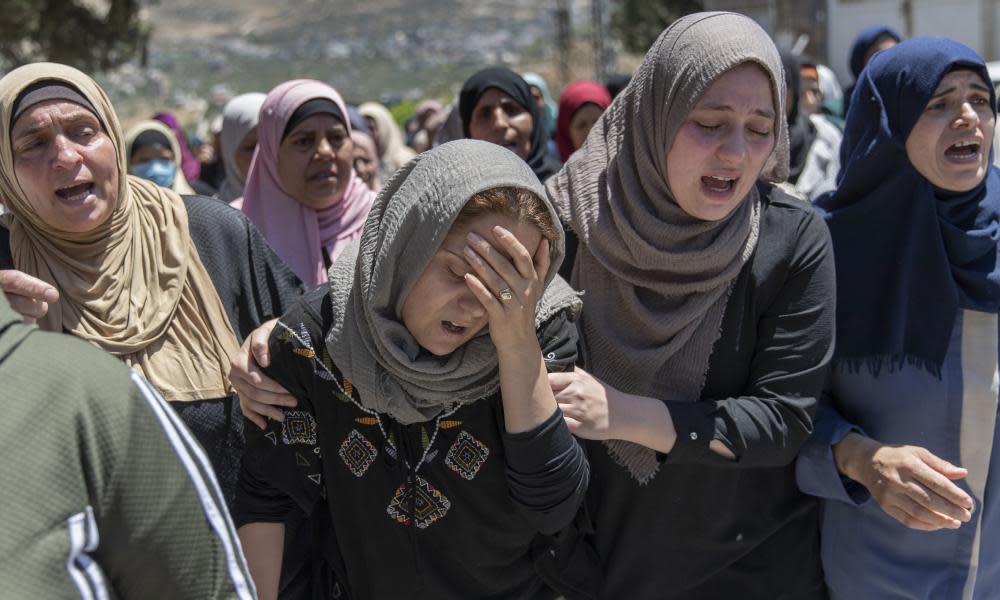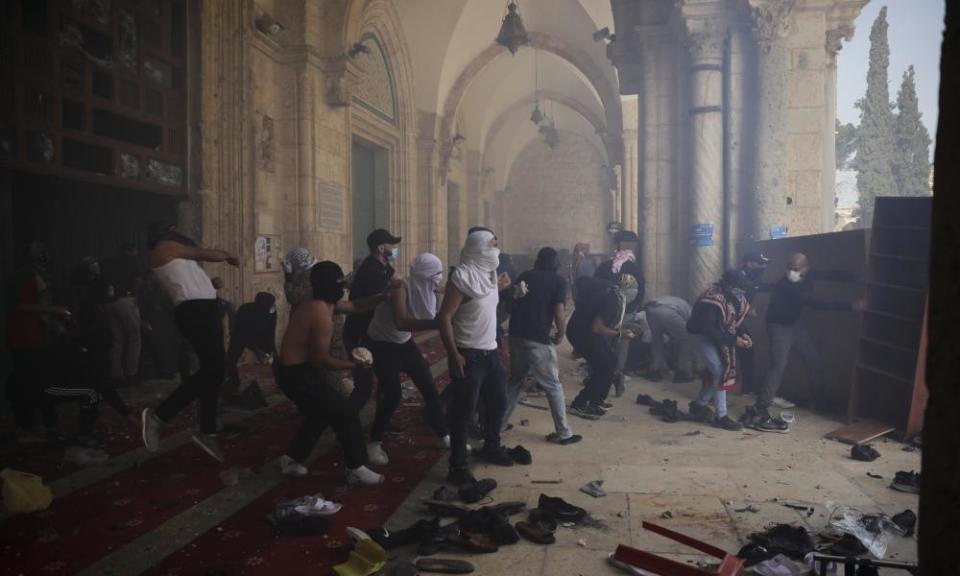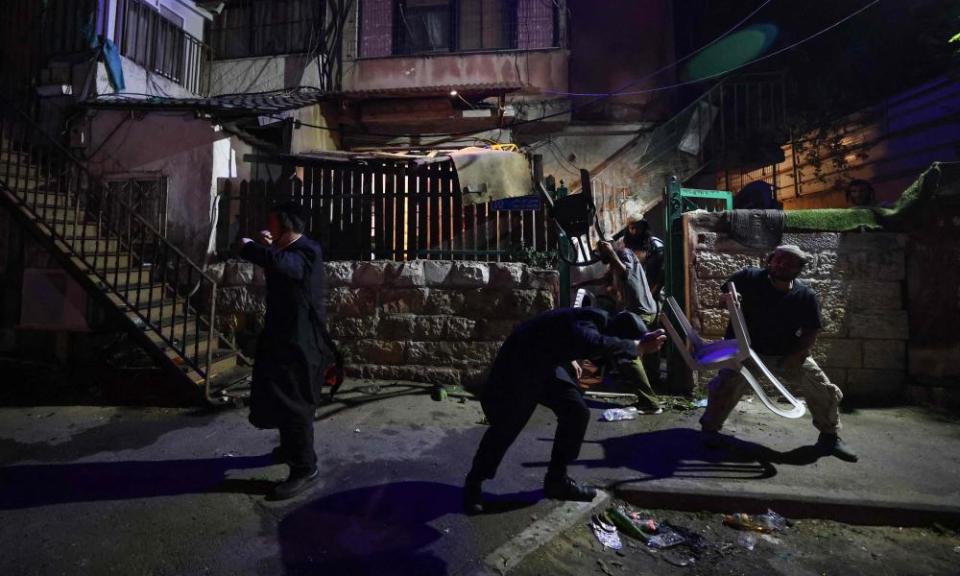A raid, a march, a court case: how Israel spiralled into a deadly conflict

Abd al-Fattah Iskafi, 71, has lived in his house on a tree-lined street near the historic Damascus Gate entrance to Jerusalem’s Old City since he was six years old. But he has spent decades locked in a court battle with hardline Jewish settlers over whether he has the right to stay.
Families in his Sheikh Jarrah neighbourhood who also face losing their homes have been “destroyed psychologically” by the long legal fight, he says. But as lawyers prepared this month for a final showdown in Israel’s highest court, fallout from the case spread far beyond their neighbourhood.
For many Palestinians, the battle has become emblematic of what they see as a campaign to force them out of East Jerusalem. Anger at potential evictions fuelled broader tensions that over the last week exploded into communal violence inside Israel and a new war with Hamas.
Two different religious calendars and the slow-moving wheels of court bureaucracy all conspired to make 10 May a deadly flashpoint.

That day, Israel’s supreme court was due to hear the Sheikh Jarrah case. Also on that Monday, the 28th day of the Hebrew month of Iyer, Israeli nationalists were planning to hold a controversial annual “Jerusalem Day” march through Muslim quarters of the Old City, marking Israel’s capture of Jerusalem during the Six Day war in 1967.
Meanwhile Muslims were nearing the end of the holy month of Ramadan, with large crowds gathered every night to pray and celebrate in the Haram al-Sharif compound, site of the al-Aqsa mosque, known to Jews as the Temple Mount.
Fury and grief over the evictions, the decision to ban traditional Ramadan gatherings in the square beside Damascus Gate, and other incidents including riots by the far-right Jewish group Lehava, had spurred weeks of clashes between Palestinians and police in the city, including at one of the most sacred sites in Islam.
“[Violence at] al-Aqsa mosque is probably the number one reason for most of the escalation,” said Raviv Drucker, a political analyst for Channel 13 television. “Even though Israel is aware of the sensitivity of the place, for some reason we make the same mistake over and over again. To break into the mosque with grenades and all of these things, it adds to the fire when you have this tension all around, of Ramadan, and Eid al-Fitr and Jerusalem Day, all together.”
There were tensions among Jewish Israelis too. A TikTok video of a Palestinian teen hitting a Jewish man on a train had gone viral in mid-April, generating copycat attacks and widespread outrage.
The court hearing on Sheikh Jarrah was ultimately delayed, when the state attorney general made a last-minute request for more time to study the case. It looked like a tacit step back from the government’s insistence that the case was just a “real-estate dispute between private parties”. The Jerusalem Day march was also re-routed from Muslim areas by police, after appeals from both the military and the Shin Bet security agency. But by then the spiral of violence had gathered a momentum of its own.
Early on Monday, Israeli police stormed the Haram al-Sharif compound, firing stun grenades and teargas and clashing with Palestinians inside following days of worsening violence. That evening Hamas fired rockets into Israel from Gaza, just minutes after passing an ultimatum for Israel to withdraw its security forces from the Haram al-Sharif compound and Sheikh Jarrah. The group’s military wing claimed it struck Jerusalem in response to Israel’s “crimes and aggression in the Holy City, and its harassment of our people in Sheikh Jarrah and al-Aqsa mosque”.

The Sheikh Jarrah case is incendiary for many Palestinians because would-be settlers cite an Israeli law allowing Jews to reclaim ownership of property lost before 1948. Palestinians have no equivalent legal means to reclaim property that became part of the state of Israel at the same time. “The law is written to privilege Jews over non-Jews. It is house-by-house, neighbourhood-by-neighbourhood apartheid,” said Yousef Munayyer, a Palestinian political analyst.
The families at the heart of the dispute have lived there since the 1950s, after being forced to abandon or flee their homes in the fighting that preceded the declaration of the state of Israel in 1948. They were rehoused in Sheikh Jarrah by the UN.
“The settlers are thieves supported by the government. We will not leave our homes,” said Muhammad al-Sabbagh, 71, a plumber who has lived in Sheikh Jarrah for 56 years.
That anger, and resentment of life as second-class citizens, also contributed to an unprecedented and devastating wave of communal violence that erupted in Israeli towns with mixed Jewish and Arab populations over the last week. It included mobs rampaging through businesses and destroying places of worship, street beatings and attempted raids on homes. It was a disturbing new dimension to a conflict whose other aspects, including Israeli airstrikes on Gaza and rockets from Gaza falling into Israel, have played out before during previous outbreaks of hostilities.

Rights groups in Israel have long documented systemic discrimination against Palestinian citizens of the country. Most live in Arab-majority towns that are poorly resourced, with higher levels of unemployment and overcrowded housing. In 2018, the Knesset passed a “Jewish nation-state” law, which declared only Jews had the right to self-determination in Israel and stripped Arabic of its status as an official language alongside Hebrew.
At the time, Ayman Odeh, the head of the Israeli Arab Joint List group of parties, said the Knesset had passed “a law of Jewish supremacy and told us that we will always be second-class citizens”. Before a general election the following year, prime minister Benjamin Netanyahu wrote on Instagram: “Israel is not a state of all its citizens … Israel is the nation-state of the Jewish people – and them alone.” Yet nearly two million Israelis, or 20% of the population, are Palestinian – mainly Muslim, but some Christians and some Druze. Nearly all are descendants of people who remained in Israel after the state was declared in May 1948. Most were offered citizenship of the new state.
They have family in the occupied West Bank, East Jerusalem, Gaza or among the refugee communities of Jordan, Lebanon and elsewhere.
Many fear the wounds of communal violence will take years to heal, but Prof Gideon Rahat, senior fellow in the political reform programme at the Israel Democracy Institute, said the attacks had horrified most of Israeli society, and he believed deep economic integration would help restore faith between communities.
“We are mixed in everyday life more than ever before, and most of the people are not part of this violence,” Rahat said, citing demonstrations against the violence by both Jews and Arabs and a range of politicians speaking out. “Even people from the right wing are trying to put the fire out. Of course the extreme right are happy about the situation as they want to have a zero-sum game, but many of the other forces are trying.”

Even without the fallout from communal violence, the conflict has reshaped the Israeli political landscape overnight.
Long-serving prime minister Netanyahu was on the brink of losing his post to a nearly formed coalition government, after failing to secure a majority in the fourth general election in two years. The deal being brokered by Yair Lapid, centrist leader of the opposition, would have brought an Arab Israeli party into government for the first time in Israel’s history. The negotiations have all but collapsed; the Islamist party Raam has withdrawn.
The conflict has also partly neutralised Benny Gantz, who is defence minister but also one of Netanyahu’s main rivals for power and key to any coalition. He is now focused on the military campaign, and working closely with the prime minister.
“Netanyahu was days away from getting ousted. [The new coalition] was already set up and ready to go,” said Drucker, the Channel 13 analyst.
“Surely this escalation served him very, very well, because this government that was formed just collapsed. And he will be staying in office in the coming months, maybe for a few years.”

 Yahoo Movies
Yahoo Movies 
